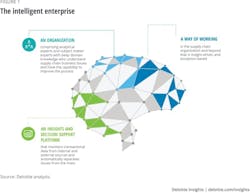Supply Chain of the Future Will Use Intelligent Enterprise Model
Recognizing digital technologies’ importance in helping companies manage their supply chain, Deloitte offers some practical advice about developing a new model that “simulates how any change in supply networks, product design, sales opportunities, or customer mix would impact the entire enterprise.”
In an article, the authors believe that this new model will use data that can be analyzed by AI and ML as well as other digital algorithms to “help problems before they occur, and run multiple simulations based on business objectives and priorities to determine potential consequences and trade-offs throughout the enterprise.”
They note that an intelligent enterprise will require the following components—an insights and decision platform, a digital organization, and a digital operating model.
An insights and decision platform
To make intelligent decisions in large, complex supply chains, operators should understand how their actions anywhere will impact the enterprise everywhere. Process automation enables managers to make decisions based on the rapid analysis of potential decision points and how those will impact the entire organization. To do this, the insights and decision platform must include the technology and tools necessary to access both internal and external data sources, captured in real-time and organized into a single data model, made available to supply chain operators through a rules-driven, cloud-based layer that spans the enterprise. AI/ML capabilities will subsequently be used to conduct in-the-moment analysis. The findings can then be used not only to respond to supply chain exceptions but also to guide the identification and automation of manual processes and non–value-add decisions.
A digital organization
To bring the organizational model up to speed with the capabilities of advanced technologies, the organization needs to operate from one integrated data layer, pulling data into one rationalized dataset, accessible to the entire enterprise. AI and other sophisticated analytics solutions, meanwhile, will expedite problem-solving. The result: What would have previously taken days to perform manually within one department will now be executed in a matter of minutes using data from across the organization.
A digital operating model
The digital operating model will become operational through a series of codified business rules that will support the new customer-centric, rapid-response approach. The goal of the operating model is to help identify and address the root cause of problems. In effect, this model assumes that supply chain disruption is an eventuality, rather than an exception. The technology layer provides a common, integrated data repository (single version of the truth) that will be accessed by roles across the enterprise to help ensure enterprisewide impact. In this model, performance measurement and incentives will be associated through a common, holistic set of metrics




